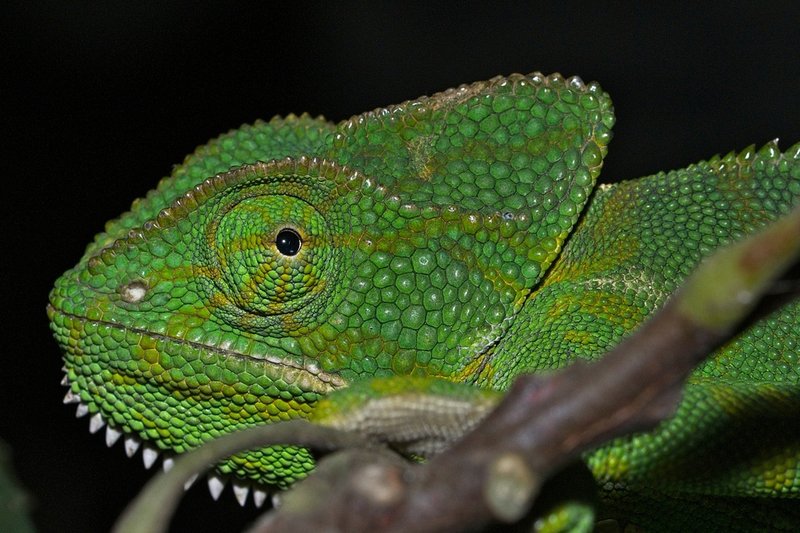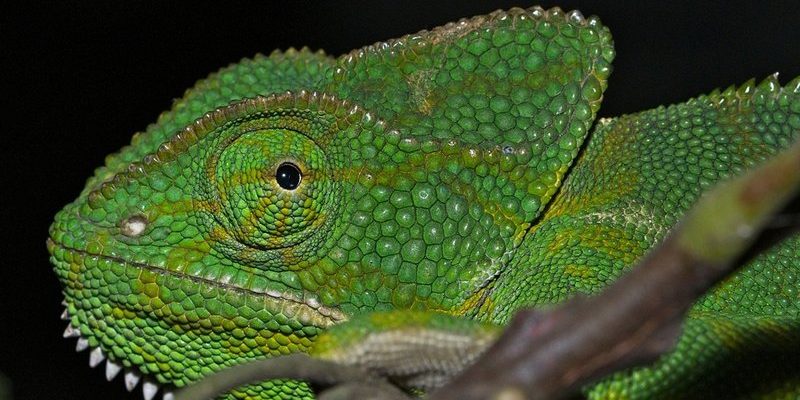
The Indian Chameleon, often seen lounging on branches and leaves, is not just another lizard in the vast animal kingdom. This incredible reptile, with its dazzling colors and unique behaviors, is a wonder of nature. When you spot one, you might be struck by its ability to blend into its surroundings, a skill that makes it a fascinating subject for both wildlife enthusiasts and everyday observers. Imagine trying to find a needle in a haystack—this is what spotting an Indian Chameleon can feel like when it’s in full camouflage mode!
But there’s much more to the Indian Chameleon than its color-shifting capabilities. From its habitat to its diet and everything in between, this creature holds secrets that can intrigue anyone who takes the time to learn about it. So grab a cup of coffee, settle in, and let’s explore the captivating world of the Indian Chameleon together.
What is an Indian Chameleon?
The Indian Chameleon, scientifically known as Chamaeleo zeylanicus, is a species of chameleon native to the Indian subcontinent. These lizards are known for their remarkable ability to change colors, which they do for various reasons, including camouflage, communication, and temperature regulation. Unlike some other chameleon species, the Indian Chameleon is relatively small, with adults typically growing to about 10 to 15 inches in length. Its body is adorned with varying shades of green, brown, or yellow, enabling it to blend seamlessly into its environment.
These chameleons inhabit tropical and subtropical regions, preferring foliage-rich areas like forests, gardens, and even urban settings. Although their appearance can be quite vibrant, they can also mimic the colors of the leaves and branches around them, making them a master of disguise in the wild. The Indian Chameleon is part of a larger family that includes over 200 species, each boasting its own fascinating adaptations.
Physical Characteristics
The physical traits of the Indian Chameleon are quite striking. Its eyes can move independently, allowing it to survey its surroundings without turning its head. This unique adaptation is useful for spotting predators or potential prey. Their eyes are large, bulging, and can be a vibrant yellow or orange, adding to their charm. Coupled with their long, flexible tongues—often extending twice the length of their body—they are perfectly equipped for catching insects.
One of the more intriguing aspects of their anatomy is their zygodactylous feet. These feet are split into two opposable parts, somewhat like human thumbs, which help them grip branches and navigate through trees with ease. This design not only aids in climbing but also plays a role in their hunting techniques, giving them better dexterity to snatch insects out of the air.
| Characteristic | Details |
| Size | 10 to 15 inches in length |
| Habitat | Tropical and subtropical forests, gardens, and urban areas |
| Diet | Primarily insects (grasshoppers, crickets, etc.) |
| Lifespan | 5 to 7 years in the wild |
| Color Change | Regulates temperature, communicates, and camouflages |
Habitat and Distribution
The Indian Chameleon thrives in a variety of habitats, but it particularly prefers areas where plant life is abundant. You’ll find them in tropical and subtropical forests, as well as gardens, where they can easily hide among the foliage. Their distribution stretches across India, Sri Lanka, and even parts of Bangladesh. They are adaptable creatures, often making their homes in urban areas where there is sufficient vegetation.
These chameleons are arboreal, meaning they spend most of their lives in trees or shrubs. This behavior not only provides them with ample camouflage but also gives them access to a wide range of insects that make up their diet. They are known to be territorial, often choosing a particular spot in a bush or tree to claim as their own. If another chameleon encroaches, you might witness some fascinating displays of color changes as they signal their dominance.
Diet and Feeding Habits
When it comes to food, the Indian Chameleon is quite the insectivore. Its diet primarily consists of a variety of insects—grasshoppers, crickets, and moths make up the bulk of what they eat. Their hunting technique is a sight to behold: after spotting potential prey, they carefully extend their long tongues, which can be up to twice the length of their bodies, to capture it in one swift motion. They can catch their prey with astonishing speed and precision, which is essential for survival.
Feeding is not just about catching insects; it’s also a social affair. When multiple chameleons are present, you might see them compete for food. They can communicate their readiness to fight or defend their territory through color changes. A chameleon displaying brighter and more vibrant colors might signal strength, warning others to back off from a food source. This behavior adds an exciting layer to their feeding habits.
Behavior and Adaptations
The behavior of the Indian Chameleon is intricate and fascinating. Primarily solitary creatures, they enjoy basking in the sun to regulate their body temperature. If it gets too hot, they can change their color to a lighter shade, which reflects sunlight and helps cool them down. Conversely, when it’s cooler, they may turn darker to absorb more heat.
Camouflage is perhaps the most celebrated behavior of the Indian Chameleon. When threatened, they can blend seamlessly into their surroundings, making it nearly impossible for predators to spot them. This skill is not just for show; it’s a vital survival tactic that keeps them out of harm’s way. Additionally, they exhibit territorial behavior, often displaying their colors to warn off rival chameleons. These displays can be quite dramatic, involving shifts in hue, body posture, and even tail movements.
Reproduction and Lifecycle
Reproduction in the Indian Chameleon is a fascinating process. Mating season typically occurs during the warmer months when food is plentiful. Males engage in vivid color displays to attract females, showcasing their strength and genetic fitness. After a successful courtship, the female lays eggs, usually in a secluded spot in the ground or in leaf litter to keep them safe from predators.
Eggs usually take about 4 to 6 weeks to hatch. The young chameleons are tiny replicas of their parents, ready to fend for themselves from day one. They are born with the same color-changing abilities but rely heavily on their ability to camouflage to avoid becoming prey. As they grow, they will shed their skin multiple times—each shedding making way for a more robust and colorful adult chameleon.
Conservation Status
The conservation status of the Indian Chameleon is currently stable, but habitat loss due to deforestation and urbanization poses a potential threat. As their natural habitats diminish, these chameleons face challenges in finding sufficient food and shelter. Conservation efforts are crucial to ensure that these remarkable lizards continue to thrive in their native environments.
Local awareness and education on the importance of preserving habitats can make a significant difference. Community efforts to maintain green spaces in urban areas help sustain populations of Indian Chameleons and other wildlife. Supporting organizations focused on habitat conservation can also aid in protecting these vibrant creatures for future generations.
FAQ
What is the average lifespan of an Indian Chameleon?
Indian Chameleons typically live around 5 to 7 years in the wild, though their lifespan can be affected by environmental factors such as habitat quality, availability of food, and predation pressures. In captivity, with proper care, they may live longer due to reduced stress and more stable conditions.
How do Indian Chameleons change color?
The color change in Indian Chameleons is a complex process influenced primarily by their mood, temperature, and environmental factors. When feeling threatened or stressed, they might display brighter or more vivid colors to deter predators. Meanwhile, shifts in temperature can cause them to adjust their colors to help regulate their body heat, changing to lighter shades in the heat or darker hues when it’s cooler.
Are Indian Chameleons good pets?
While Indian Chameleons can be kept as pets, they require specific care and conditions to thrive. They need a well-planted enclosure with ample climbing space, humidity control, and a specific diet of live insects. Potential owners should be prepared for their unique needs and understand that they thrive best in environments that replicate their natural habitat.
Do Indian Chameleons have any natural predators?
Yes, Indian Chameleons face threats from a variety of predators in their natural habitats. Birds of prey, snakes, and even larger reptiles may see these vibrant lizards as a source of food. Their ability to camouflage helps them evade many of these threats, but they must always be vigilant.
Can Indian Chameleons see in color?
Absolutely! Indian Chameleons have excellent vision and can see a wide range of colors. This capability is significant both for finding food and for communicating with each other. Their independent eye movement allows them to survey their environment effectively, spotting potential threats and prey simultaneously.
How do they communicate with one another?
Indian Chameleons communicate primarily through color changes. These shifts can convey a range of messages, from aggression and territoriality to attraction and submission during mating rituals. They may also use body posture changes and head bobs to enhance these color signals and assert their presence.
What do Indian Chameleons eat in the wild?
In the wild, Indian Chameleons feast mainly on a diet of insects. They eat a variety of smaller creatures, such as crickets, grasshoppers, and caterpillars. Their hunting technique, which involves a rapid tongue extension, is highly effective for capturing these quick-moving insects.
Are there any special adaptations Indian Chameleons have developed for their environment?
Yes, Indian Chameleons have several adaptations that help them thrive in their environments. Their zygodactylous feet allow them to grip branches, while their color-changing abilities help them camouflage effectively. Additionally, their independent eye movement enables them to detect potential threats and prey efficiently.
What role do Indian Chameleons play in their ecosystems?
Indian Chameleons play an essential role in their ecosystems as both predators and prey. By controlling insect populations, they help maintain balance in the environment. Furthermore, as prey for birds and other predators, they contribute to the food web, supporting the survival of various species within their habitats.
How can I help protect Indian Chameleons?
Protecting Indian Chameleons can be as simple as promoting awareness about their habitats and the importance of conservation. Supporting local wildlife organizations, participating in reforestation projects, or even creating wildlife-friendly spaces in your garden can make a difference. Every small effort contributes to preserving these remarkable creatures and their ecosystems.

